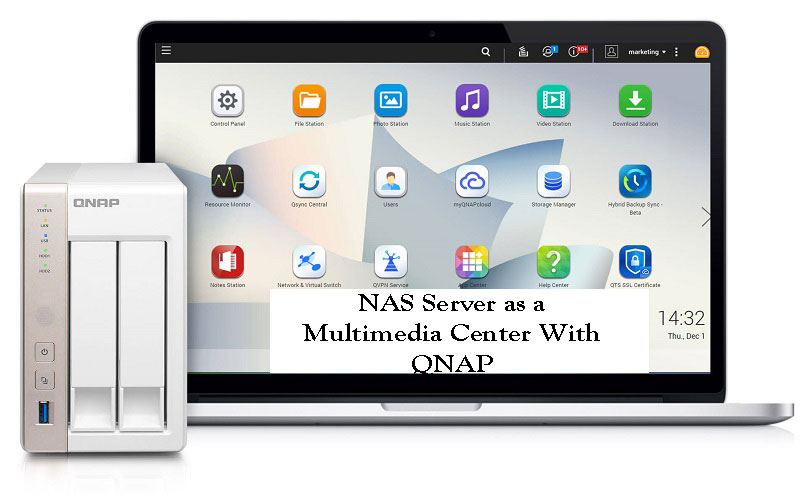
In this article we wanted to explore a little more the capabilities of a NAS server as a multimedia center, and how it can transform the way users consume and share their multimedia files.
From streaming HD video with real-time video transcoding capabilities to creating custom photo and music libraries. We will discover how a NAS server can improve the multimedia experience in our home or business through any platform.
What kind of NAS do we need to use as a media server?
A NAS is a network storage solution that allows users to centralize and share files and data on a home or business network. However, its functionality is not limited to data management, it can also become a multimedia center for the transmission of digital content.
What we expect from a multimedia server is that it has real-time video and audio transcoding capacity, sufficient transfer speeds so that the video signal reaches our monitor/television without lag or cuts, and sufficient storage capacity to store very large files.
Currently, there are models capable of giving us all these features, serve as example the QNAP TS-364 model with 3 bays + 2 M.2 slots and Intel Celeron N5095 CPU with integrated UHD graphics supporting 4K or the Synology DS420j with Realtek RTD1296 CPU. Here are the minimum specs we would recommend:
- 4-core CPU with real-time video transcoding
- 2.5 Gbps or higher network interface with DLNA, AirPlay, or Chromecast support
- 5 Gbps USB port for external storage
- HDMI for direct connection to monitor
- 2 storage bays, if we have NVME, better
- Operating system with an intuitive interface and the possibility to install additional multimedia applications
For this article, we are going to use a QNAP TS-i410X NAS that this manufacturer has lent us to carry out its corresponding analysis. The type of use for which it is intended is not so important, because it is not domestic, but to verify the video transcoding behavior of the Intel Atom x6425E processor with integrated 10th generation UHD graphics.
The objective is to implement this CPU in domestic models that improve the multimedia capabilities of Realtek CPUs and Intel Celeron a priori. We also have 4 SATA bays compatible with SSDs, double 10 GbE LAN, HDMI with 4K resolution, and 10 Gbps USB ports for external storage. On paper, it is a NAS that will be plenty for this type of task, so let’s get to work.
Assembly and use experience with a NAS server as a multimedia center
We are going to propose the configuration of a NAS server as a multimedia center touching on the three most important sections such as videos, photos, and music. To do this, we will use the applications available in the QNAP application center and the QTS 5.0.1 operating system updated to the latest available version as much as possible. This system is based on the Linux kernel, so it has the potential to install external applications such as VLC or KODI that extend the base options.
For home users, it is important to have an intuitive interface, and in this section, QTS is a bit more technical than Synology or Asustor, but all the options have well-explained wizards, starting with the initial configuration of the system. Next, we must format the hard drives and create the corresponding storage spaces. We recommend:
- Storage is set in RAID 0 configuration to take advantage of the combined capacity of 2 hard drives, or RAID 5 if we want fault tolerance and good use of capacity. With SATA SSD drives we would triple the individual data transfer speed.
- Storage volume where QNAP gives us 3 possibilities; we would recommend using Thick to optimize drive access speed and maximize data transfers, supporting snapshots and future expansion.
Photo Server
A photo server allows us to store and share photos from or between devices on different platforms in a secure local or remote cloud with high fault tolerance. In the NAS we can dump images from our Android or iOS terminal, PC, tablet, or camera to share them.
We will use the QuMagie application, which provides centralized storage where you can create personalized or automatic albums, with photo editing options, access permission management, automatic synchronization with cloud services such as Google, comment assignment, and search tools advanced. But the most interesting thing about it compared to the previous App Photo Station is that it integrates management tools based on Artificial Intelligence to recognize places, and people and classify images.
After installing the application, we only have to make sure that we have a folder, or several, to store the photos associated with the application, a procedure that we will do from FileStation and the App itself. We could assign users or permissions from the control panel, but we won’t.
Now all that remains is to start uploading photos from any local computer directly or through synchronization applications such as QSync on Windows or QuMagie on Android. It also supports remote access through myQNAPcloud with our QNAP ID which we will have available whenever we have a QNAP NAS. The transmission and processing speed is excellent with the NAS used, with photos between 5 and 20 MB locally it works smoothly and uploads photos instantly.
Doing the example with QuMagie on Android, we simply have to install the App, which will automatically detect the NAS on the local network. Next, we register with our user, to which we will have the folder associated, and we will be able to upload or download photos. In the case of remote management, instead of the user, we will put the QNAP ID. If we have a good Wi-Fi or 4G/5G connection and high data upload in our IPS it will be almost as if we were connected locally.
Music Server
To mount a music server on a NAS, the procedure is practically identical to the one carried out with the photos. We will use the Music Station application, which has the same operating system, with functions for creating personalized playlists, downloading metadata from the Internet for songs, remote access, audio quality control, and advanced search.
We associate a new shared folder to the application, and if we want, we assign users and permissions at ease, to start uploading music from any device. If before there was an App called Qphoto, indeed, now we have another one called Qmusic for Android. By default we have AAC, MP3, and MP4 codecs, so we wouldn’t have playback problems.
There we have it, with our list of songs to play, and it also works in the background just like Spotify, but without ads and with the possibility of playing any song at any time. It’s honestly the best a music enthusiast can have at home, free unlimited access anywhere.
Video Server
A NAS server as a multimedia center would not be complete without Video Station, the application that will provide us with a centralized store of movies and videos. In addition to the capabilities discussed in the previous two, Video Station recognizes the title of the movie and will connect to the Internet to download its metadata from IMDb (at least in our case) with a synopsis and user rating.
This application can transcode videos and audio in real-time or by the user’s custom resolution selection in offline mode. It can be integrated with online services such as YouTube and other platforms, create personalized albums, and manage all our content as if it were the platform itself.
By default, the codecs supplied for QTS will be the CAYIN MediaSign Player available in a basic version and another with a single payment of €12. The installation process is intended to be as simple as possible; We look for it in the App Center, which in turn will link us to the official page where the paid or free license is provided. This will automatically be installed on the NAS and on our QNAP online account, after restarting the application they will start working.
As can be seen in the list of specifications, two important codecs are missing, such as AC3 and DTS audio, so it may be incompatible with certain content downloaded from the Internet, although the one available on the usual platforms is compatible. What is the solution to this small inconvenience?
- Transcode the video ourselves into a compatible format, for example, MP4 or HEVC.
- Install some additional applications like VLC that do include these codecs.
- Choosing a different specification NAS that does have these capabilities
For Android smartphones, we have the QVideo application to connect and access the NAS in the same way as in the 2 previous scenarios. In addition, we have been able to play the movies without problems with the help of the MX player available on Google Play. It was a great subject for this NAS and the truth is that it has passed with flying colors with a very fast buffer load, without pixelations in the image or cuts. In a mobile or remote connection, the fluidity will depend on the bandwidth we have.
Conclusions on Mounting a Multimedia NAS Server
A NAS server configured as a media center can be an ideal solution for those looking for a centralized way to store and share their media content on a home or business network. Fulfilling the requirements that we have set under our experience of use, there will be no problems with pixelation, loading, or cuts in images, music, and videos.
The intuitive interface is important for home users, and the QTS system despite being a bit more technical in content than its rivals, displays well-explained and detailed wizards for every action. Video playback in real-time with this new CPU has gone smoothly except for missing some sound codecs. For this, we have seen that there are more or less comfortable solutions to solve the problem.
As for the user experience with the chosen NAS, the Intel Atom x6425E processor passed this test with high-definition movies with flying colors. We just have to give it a network infrastructure with enough bandwidth to transcode in real time. If we have a good upload, the possibilities are immense remotely using QNAP ID. Having a photo, music, and video server is the ultimate step for multimedia content enthusiasts.
We leave you other articles to get more out of QNAP NAS, a brand with which we have worked almost since our beginnings and that we know well:
